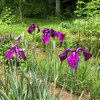Iris ensata 'Variegata' (syn. 'Silverband') - JAPANESE IRIS 'VARIEGATA'
Out of many Iris that offered, this one stands out for it's:
Durability, no care plant, healthy foliage for the whole season, silver-white variegation, early-mid season blooming (blooms when most irises are done blooming), total deer resistance, adaptability to grow in average conditions
Likes wet feet, but does fine in average moisture.
Very showy in bloom - smaller slender dark purple flowers, nicely combine with the variegation. Flowers above foliage on sturdy stems.
Honorable mention Award (1992) and Award of Garden Merit (by RHS, Britain).
Blooming Time: usually early to mid June (in our zone 6)
Size: 28" tall and 12" wide (in optimum conditions up to 36")
USDA Zones: 4 to 9
Culture: sun, half shade, average soil with some organic matter (that doesn't tend to dry out easily), clay, moist, wet or saturated soil, loam, boggy up to 6" shallow standing water. Likes neutral to slightly acidic soils, but grows well in our neutral-slightly alkaline soils too.
Moisture Needs: average to moderately moist to moist/wet, may be grown as an aquatic plant in shallow water (up to 6" deep)
Origin: The species is native to Japan, Northern China, Korea and Asian part of Russia
Black Walnut Tolerant: yes
Deer/Rabbit Resistant: yes / yes
Attracts Butterflies or Pollinators: pollinator friendly, but is not pollinator magnet
Attracts Hummingbirds: no
Pot Size: square 3.5" x 4" deep perennial pot
Plant combinations: The flower and leaf color combine easily with any other colors. Can be used as a pond plant - on the banks, shallow water, water gardens or in average to moist soil with plants with similar needs like Boltonia, Chelone, Eupatorium, Hibiscus (moscheutos, laevis, etc. and hybrids), Lobelia, Ligularia, Eupatorium, Physostegia, Primula japonica, Rodgersia, and other moisture-loving perennials.
It can also be grown in a moderately moist flower bed, combined with Amsonia, Baptisia, Euphorbia palustirs, Euphorbia griffithii, some hardy Geraniums, Geum, Hemerocallis, Monarda, Phlox paniculata, Persicaria amplexicaulis, Rudbeckia laciniata, Spigelia, Sanguisorba, Veronicastrum, most of Vernonia or grasses like Carex (sedges), Hakonechloa, Molinia, Panicum.
Picture copyright: US Perennials

Iris ensata 'Variegata' (syn. 'Silverband') - JAPANESE IRIS 'VARIEGATA'
Out of many Iris that offered, this one stands out for it's:
Durability, no care plant, healthy foliage for the whole season, silver-white variegation, early-mid season blooming (blooms when most irises are done blooming), total deer resistance, adaptability to grow in average conditions
Likes wet feet, but does fine in average moisture.
Very showy in bloom - smaller slender dark purple flowers, nicely combine with the variegation. Flowers above foliage on sturdy stems.
Honorable mention Award (1992) and Award of Garden Merit (by RHS, Britain).
Blooming Time: usually early to mid June (in our zone 6)
Size: 28" tall and 12" wide (in optimum conditions up to 36")
USDA Zones: 4 to 9
Culture: sun, half shade, average soil with some organic matter (that doesn't tend to dry out easily), clay, moist, wet or saturated soil, loam, boggy up to 6" shallow standing water. Likes neutral to slightly acidic soils, but grows well in our neutral-slightly alkaline soils too.
Moisture Needs: average to moderately moist to moist/wet, may be grown as an aquatic plant in shallow water (up to 6" deep)
Origin: The species is native to Japan, Northern China, Korea and Asian part of Russia
Black Walnut Tolerant: yes
Deer/Rabbit Resistant: yes / yes
Attracts Butterflies or Pollinators: pollinator friendly, but is not pollinator magnet
Attracts Hummingbirds: no
Pot Size: square 3.5" x 4" deep perennial pot
Plant combinations: The flower and leaf color combine easily with any other colors. Can be used as a pond plant - on the banks, shallow water, water gardens or in average to moist soil with plants with similar needs like Boltonia, Chelone, Eupatorium, Hibiscus (moscheutos, laevis, etc. and hybrids), Lobelia, Ligularia, Eupatorium, Physostegia, Primula japonica, Rodgersia, and other moisture-loving perennials.
It can also be grown in a moderately moist flower bed, combined with Amsonia, Baptisia, Euphorbia palustirs, Euphorbia griffithii, some hardy Geraniums, Geum, Hemerocallis, Monarda, Phlox paniculata, Persicaria amplexicaulis, Rudbeckia laciniata, Spigelia, Sanguisorba, Veronicastrum, most of Vernonia or grasses like Carex (sedges), Hakonechloa, Molinia, Panicum.
Picture copyright: US Perennials




